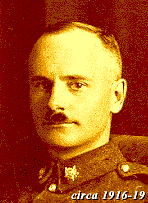14 May 1917

[photo with Martha]
Seeing the wounded soldiers, parading troops, rationing of food and gasoline in his early days in England served as a more gentle introduction to the War than what would soon follow.
After participating in the military games and athletic sports of Sandling Camp's Victoria Day celebrations, many soldiers went to the nearby sea-side resort of Folkestone. During the dinner-hour, the town came under attack by German planes. Two-winged aircraft of recent invention had been seen crossing the channel before, but they were usually flying reconnaissance missions. These were huge Gotha bombers, and killed 76 coastal holidayers, and four soldiers from George's battalion. (18)
Air raids became frequent occurrences over the summer months, often interrupting marches and church parades. At one occasion a training inspection was cancelled, while from the parade ground the men watched Allied fighters engage enemy planes over Dover.
Summer 1917
During a lull in traffic at Sandling, George spent some in September training at Tilmanstone, Kent. The trainees slept in bivouacs, and practiced maneuvers, delayed actions, counter attacking, all the while harassed by the day-and-night German air raids. The air war eased off during the fall, partly due to losses over Flanders, but growing news of a truce on the Eastern Front sent chills through the Allied troops. The Russian Czar had abdicated, and Lenin now ruled a Bolshevik government. Cessation of fighting in Russia, and major victories in Italy and Galicia brought more German troops back to the Western Front.
For George, there was a quiet yet final Christmas in England and by February, 1918, Sandling Camp was again the scene of mass troop movements. The Americans had arrived over the last few months and were training in France near the Western Front. Knowing the Germans would attack before their preparations were complete, British Imperial troops were also digging-in. The Canadian corps was stationed in the north and needed more men to bolster their defenses.
22 Feb 1918